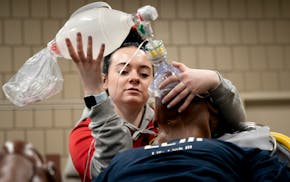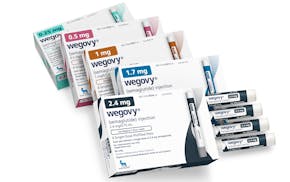Twin Cities area hospitals have cut their use of donated blood by thousands of units over the last five years, abandoning long-held but thinly researched criteria about which patients need transfusions after surgery and those who do not.
Allina Health estimates its 12 hospitals have used 14,000 fewer units of blood since January 2010, when it adopted research-based standards that reduced the number of anemic patients who received transfusions after surgery, and the amount of blood given per transfusion.
"If you're bleeding out, blood is going to save your life," said Dr. Lauren Anthony, a pathologist who led Allina's efforts to reduce transfusions. "But if you're not bleeding out, blood is not as beneficial as they used to think it was."
The change has profound consequences for many hospitals, given that each transfusion costs hundreds of dollars and puts patients at risk of complications.
But it has occurred mostly out of public view. Patients often have little idea that transfusions weren't provided to them. Hospitals and blood banks have also been delicate about delivering the news, for fear that people might conclude they don't need to donate any more.
Blood remains a "precious gift" that is lifesaving for patients suffering from cancer, heart problems, traumatic injuries and other medical problems, said Dr. Jed Gorlin, medical director of Memorial Blood Centers, a St. Paul-based blood donor agency. "When we ask for it, we need it," he said. "We don't ever want to cry wolf."
But because transfusions are considered "liquid transplants," they present risks including infections, prolonged hospital stays, and hypervolemia — a condition that results when patients have too much blood filling their veins.
As a result, hospitals have used multiple strategies to reduce blood use, particularly in patients undergoing cardiac and orthopedic surgeries.
The main strategy has been lowering the hemoglobin measurement hospitals use to indicate the need for a transfusion. Hemoglobin gives blood its red color and aids in the transfer of oxygen and carbon dioxide to and from red blood cells. A healthy level in adults is around 13 grams per deciliter.
Transfusions used to be ordered if patients had anemia, a blood cell deficiency that causes weakness and fatigue, and hemoglobin readings of 8 to 10. Now, transfusions aren't considered until readings are as low as 7 — unless patients are showing significant symptoms related to their blood loss.
The American Association of Blood Banks made that a formal guideline in 2012.
Body did its job
Tammy Labey, 54, had no idea she was passed over for a transfusion this August until she looked back at medical records from her double knee replacement at Regions Hospital in St. Paul and discovered she had been anemic.
The hospital, in partnership with the American Red Cross' local blood donor agency, has achieved a 14 percent reduction in blood use among orthopedic patients since 2011.
The Realtor from White Bear Lake was on such heavy pain medication during her postoperative recovery that she was hallucinating. So she can't recall if doctors ever talked about a transfusion.
"In the end," she said, "I guess my body just did what they hoped it would do and reproduced the blood."
Labey had discussed banking some of her blood before surgery, because transfusions of patients' own blood can be safer. But she didn't have enough time before the surgery to replace the lost blood.
The reduced demand for blood has created dilemmas for the Twin Cities' two blood donor agencies, Red Cross and Memorial. They have cut back collection events by 10 to 20 percent and reduced staff, primarily through attrition.
Both have been careful to maintain their efficiency — only 1 to 2 percent of the red blood units they collect go to waste because they aren't used in the prescribed time frame of 42 days.
They also have maintained a typical three- to five-day supply of blood for the hospitals they serve, which is important given the potential for unexpected trauma or emergencies.
A Memorial spokeswoman said Children's Hospital in St. Paul recently needed 100 red blood units for one surgery. And while the Red Cross saw its collection of red blood decline 6 percent from 2009 to 2012, it still needs around 675 units every day to meet hospitals' needs.
'Blood police'
In addition to eliminating transfusions, hospitals are simply using less blood per transfusion. The savings have been significant. While blood is donated, the need to test it for infectious agents and ship it to hospitals brings the price to $200 to $300 per unit.
The standard for years had been that patients needed two units of blood for transfusions to be effective, but that was based largely on flawed logic, Anthony said.
If donors suffered no ill effects when giving a single unit of blood, then doctors reasoned that recipients needed at least two units to gain any benefit. Studies have since proved that single-unit transfusions are equally effective in many cases — and safer.
The slogan "Why Give 2 When 1 Will Do" now appears on posters in hospitals throughout the metro area.
Pathologists in local hospitals have gone beyond the usual lectures, posters and memos to get the message across. At Allina, the change occurred with the help of a parody "Blood Police" DVD, in which a fictional blood cop pulls over a doctor and nurse for ordering an unnecessary transfusion.
"I'm sorry. I'm going to have to cite you for ordering a transfusion without a clinical assessment," said the blood cop, played by Dr. Dirck Rilla, a perfusionist whose day job is to keep patients' blood flowing during open-heart surgeries.
Dr. Kathrine Frey believes she has become a real-life blood cop to doctors and nurses at Fairview Southdale Hospital, where efforts she led reduced blood usage by about 3,000 units per year.
"If I look at them funny, they say, 'I didn't do it! I didn't transfuse that patient,' " the pathologist said.
Frey demonstrated the need for reducing transfusions at Southdale by creating "blood mountain," a stack of cardboard boxes that approximated the red blood units used unnecessarily each year.
"This has been the most joyful, rewarding work I have ever done," Frey said, "because you can really see the difference. You bring the blood units down, you know the patients are safer and you save the hospital significant money."
Jeremy Olson • 612-673-7744

Mahnomen hospital shutters inpatient beds to survive, a first in Minnesota

Hospitals too busy to train Minnesota paramedic students, exacerbating shortage

Minnesota pharmacies want permission, funding to administer vaccines

Showdown set between Minnesota and drug industry over rising costs

